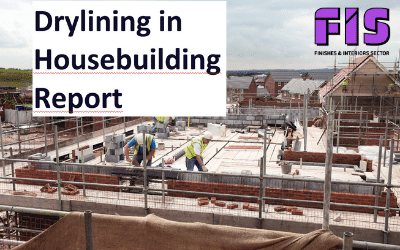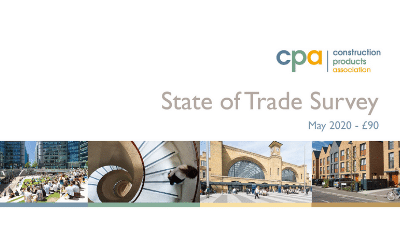
FIS develop training qualification for drylining in housebuilding
The Finishes and Interiors Sector (FIS) has today announced a new industry qualification. The Drylining in Housebuilding qualification has been created by National Open College Networks (NOCN) to address the lack of a recognised qualification for the sector specific skill and support a more robust approach to training and measuring competence.
Housebuilding makes up approximately one third of the drylining marketplace with some businesses and individuals focused entirely on this market. The new qualification offers a flexible delivery approach and specific trained outcome to support both employers and individuals to by a step by step approach to demonstrate competence in a vocational setting. It ensures that those companies and individuals investing in training can be supported with funding even if they are not able to offer the full scope of experience required to meet the new English Drylining Apprenticeship Standard.
The FIS supported by industry partners created a working group to identify the skills and agree the level of training required to create a standalone qualification. The working group comprised Construction Industry Training Board (CITB) standards team, NOCN, Home Builders Federation (HBF) along with colleges and training providers.
The project objectives were to:
- Develop standardised, formally recognised training that enables the delivery of drylining within housebuilding.
- Identify and agree the funding available that will enable the delivery of the training.
- Ensure quality of provision of training in the right locations.
The outcome is an Office of the Qualifications Examinations Regulators (OfQual) registered training qualification that can be delivered on housebuilding sites at the point of installation with a formal trained outcome and national recognition. The training can be delivered in-house by a qualified instructor, this can be a suitably qualified employee (e.g. Level 3 Award in Education and Training (PTLLS), which can be achieved in 5 days) or an independent trainer. In order to ensure quality, sites will need the required resources as specified in the NOCN qualification criteria.
NOCN Executive Director of Job Cards and Services, Mark Buckton, said: “NOCN has been delighted to work with FIS on the drylining in housebuilding qualification. At NOCN we know that specialist trades are absolutely vital to the success of the industry and in accomplishing the aims of the nation, like achieving the Government’s housebuilding targets. The drylining in housebuilding qualification fitted perfectly into the new suite of construction training qualifications, where we have totally redesigned each trade’s syllabus and provided greater teaching and learning materials. NOCN is dedicated to ensuring we provide top quality qualifications for both specialist and the larger trades.”
This project clearly highlighted the need for a new qualification for dryliners in the housing sector. This is now complete and ready to deliver. With training providers and colleges working alongside contractors and individuals, together with the support of the FIS, housebuilders and the backing of CITB, it is unanimously agreed the form of qualification and method of delivery will provide a solution that the construction industry needs.
HBF Home Building Skills Partnership Manager, Sara Cartin, said: “The new qualification will help to deliver quality workmanship to industry-agreed standards for home buyers. It is another key part of our skills framework and, combined with the virtual skills cards we are developing, will ensure that training gaps are addressed”.
FIS CEO, Iain McIlwee, said: “It is vital that we move the conversation about skills onto supporting competence within our workforce. As part of this project, we interrogated the current training situation for the housebuilding market and it was clear intervention was needed to support change and help our community meet future skills needs. The key aspect of this is the flexibility that it delivers within a framework.
We often talk of sectors as though they are one harmonious constant, but this is not the case. From business to business and throughout the regions of the UK there are different practical considerations. Within this work we have been mindful of the employer-defined competency requirements. With the support of training providers, housebuilders, and specialist contractors, we have ensured this trained outcome can be adapted to meet specific workplace requirements.
We are grateful to CITB and particularly NOCN for their support in targeting and delivering this new qualification. We are confident that it will be a valuable, new asset to support the measurement and management of competence in the sector”.
The Drylining in Housebuilding Report can be downloaded here.
ENDS
Editor notes
- FIS is the representative body for the £10 billion finishes and interiors sector in the UK. The FIS has more than 500 members drawn from contractors, manufacturers and distributers of ceilings, facades, partitions, plastering, drywall and specialist interior fit-out and refurbishment businesses.
FIS exists to support its members, improve safety, minimise risk, enhance productivity and drive innovation in the sector. As well as specialist publications, technical support and expert helplines, FIS is a dynamic network that brings the sector together through a range of events, awards and specialist working groups, all aimed at sharing best practice, setting standards and advising Government, that help its members to improve performance and win work. Members of the FIS are subjected to an audit and vetting process when they join and then again, every three years that underpins the values by which the organisation operates. To drive quality and ensure the future sustainability of the sector, FIS has a dedicated skills and training team and works with a number of Approved Training Providers to attract new people to the sector and deliver a fully qualified and competent workforce.
FIS is dedicated to collaboration in construction and a proud member of BuildUK, the Construction Products Association and the Passive Fire Protection Forum.
- The Home Building Skills Partnership (HBSP) was set up by the Home Builders Federation in 2016 (initially funded by CITB) and is a collaboration of home builders and supply chain organisations working together to attract and develop the workforce of the future and in doing so change the culture of the home building sector.
- For more information contact: George Swann – FIS Skills and Training Manager
Finishes and Interiors Sector Olton Bridge, 245 Warwick Road Solihull
West Midlands B92 7AH
www.thefis.org
E-mail: georgeswann@thefis.org
Tel: +44 (0)121 707 0077
Mobile: +44 (0)7792 959481
The Drylining in Housebuilding Report can be downloaded from our Skills Hub:





